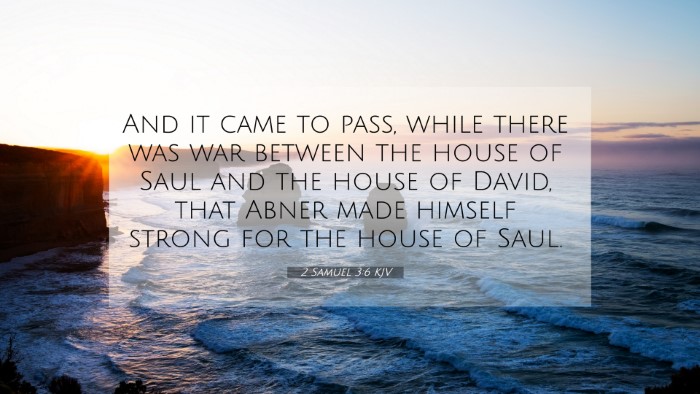Understanding 2 Samuel 3:6
Verse Text: "And it was so, while there was war between the house of Saul and the house of David, that Abner made himself strong for the house of Saul." - 2 Samuel 3:6
This verse is pivotal in the narrative of the transition from Saul's kingship to David's, illustrating the political complexity during this period of Israel's history. Let's explore its meaning through insights from notable public domain commentaries.
Summary of Insights
-
Matthew Henry's Commentary:
Henry emphasizes the conflict between the houses of Saul and David, portraying Abner as a significant figure who, although loyal to Saul's lineage, begins to challenge the status quo. His efforts to strengthen Saul's house reflect the tensions of the time, as factions vie for power.
-
Albert Barnes' Notes:
Barnes notes that Abner's actions are not just political; they reveal deeper themes of loyalty, ambition, and the consequences of factionalism. His making himself strong indicates a concerted effort to unify the northern tribes under Saul's name, despite the rising popularity of David. This highlights the ongoing struggle for the united kingdom of Israel.
-
Adam Clarke's Commentary:
Clarke provides insight into the historical and cultural context, explaining how the civil war between these two factions was not merely a clash of arms but a profound societal upheaval. He suggests that this conflict was foreshadowed and necessary for the eventual establishment of David's reign.
Thematic Connections and Cross-References
To deepen our understanding of 2 Samuel 3:6, we can explore various cross-references that illuminate the themes of conflict, leadership, and divine purpose within Scripture. Here are several pertinent verses:
- 1 Samuel 16:13 - The anointing of David by Samuel foreshadows his future kingship.
- 2 Samuel 2:10 - This verse establishes the reign of Ishbosheth, Saul's son, contrasting David’s legitimacy.
- 2 Samuel 3:1 - Highlights the ongoing war between the two houses, setting the stage for Abner's actions.
- 1 Chronicles 12:23-40 - Lists the warriors from the tribes who supported David, emphasizing his growing acceptance.
- 1 Samuel 31:6 - Describes Saul's death, which intensifies the power struggle between his followers and David.
- 2 Samuel 5:1-3 - David's eventual acceptance as king over all Israel illustrates the outcome of this conflict.
- Psalm 78:70-72 - Reflects on God's choice of David, reinforcing the theme of divine favor amidst human conflict.
Inter-Biblical Dialogue
The events in 2 Samuel 3:6 encapsulate a crucial moment in Israel's history. Cross-referencing provides invaluable methods for understanding how this verse connects to broader Biblical themes.
Through cross-referencing Biblical texts, we uncover the organic development of Israel's monarchy and God's providential plan through these tumultuous times.
Tools for Bible Cross-Referencing
In engaging with this narrative, various tools for Bible cross-referencing can be applied. Utilizing a Bible concordance or a Bible cross-reference guide allows readers to identify relevant verses that enhance understanding. Here are some methods:
- Bible Concordance: Navigate specific topics or names to find relevant scriptures.
- Cross-Reference Bible Study: Engage in thematic analysis connecting similar verses.
- Bible Reference Resources: Utilize dedicated resources that compile related texts for comprehensive study.
- Bible Chain References: Follow a chain of related verses that explore a theme such as leadership or conflict.
Conclusion
2 Samuel 3:6 serves as a pivotal junction within Scripture where themes of power, conflict, and divine sovereignty are interwoven. By employing effective cross-referencing methods and exploring correlated verses, we can gain a clearer understanding of the complex dynamics at play between the houses of Saul and David.
For those seeking to deepen their understanding of Biblical themes through effective cross-referencing Bible study methods, engaging with these scriptures will yield rich insights and broaden one's grasp of God’s unfolding narrative throughout history.









